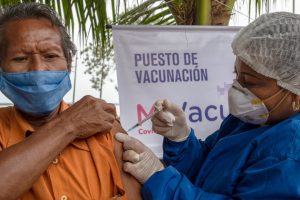During the recent months in India, the second wave of the spread of the COVID-19 pandemic has brought with it unprecedented destruction. The country’s poorest and most vulnerable communities, including women and girls, have faced immense difficulties in overcoming economic challenges and reducing the brunt of the health crisis.
Women were tasked with taking care of their families, sustaining livelihoods, and spearheading efforts in the fight against the pandemic, at a time when the threat of a third wave is looming.
UN Women and health experts striving for women’s empowerment have answered frequently asked questions regarding the Kovid-19 health crisis and its impact on women and girls.
Are women more at risk of getting infected with Kovid-19 than men?
In India, more than 30 million people have been infected by the coronavirus. Kovid-19 can infect people of all ages and genders.
However, women and girls may be at higher risk, as they are poor and lack information and resources. Or, they are also often associated with care and work in the health and services sector.
A large number of women in India are employed as health care workers, and more than 80 percent of nurses and midwives are women.
Despite this, they are often absent when it comes to decision-making in the health sector, and their salaries are also lower than their male counterparts.
Only 13 percent of the total members in the National Kovid-19 Task Force are women.
Some women in India spend more time at home caring for children, the elderly and sick families. Masks and other personal protective equipment are often tailored to the needs of men, so women are at a higher risk of contracting the virus.
At present, there is also a concern that compared to men, less number of women are being vaccinated in India.
National statistics show that 17% more men have been partially or fully vaccinated. There are only two states where the number of women receiving supplements is high.
Women and children at a community center in Batla House area, New Delhi.
In addition, women have relatively little access to the Internet and smart phones, so in some cases it is not easy for them to register for vaccination.
Due to patriarchal norms prevailing in the society, it can be difficult for women to go to vaccination centers alone. Priority may also be given to vaccination of male members in families first.
There are also myths that the vaccine also affects the fertility of women.
Women who have not received the vaccine are at higher risk of becoming infected, especially in the event of the spread of a new variant.
How has COVID-19 affected employment for women in India?
Wage disparities and the burden of unpaid care work have left a large number of women out of employment and vulnerable to poverty.
Even before the global pandemic, women’s earnings in India were only 20 percent of men’s earnings. Globally and in India, women have lost a significant number of jobs during COVID-19.
A new report by the Center for Sustainable Employment at Azim Premji University shows that in the year 2020, 47 percent of women lost their jobs during the first lockdown in India, while for men this figure is 7 percent. .
Then these women could not return to employment till the end of the year. The conditions are even worse for women in the informal sector.
In March and April 2021, the loss of employment in the informal sector affected 80 per cent of rural Indian women.
Indian women spend more time in unpaid care work than men. On average, they spend 9.8 times more time than men in unpaid household chores.
In addition, she spends an average of 4.5 hours looking after children, caring for the elderly and the sick. During the pandemic, their share in unpaid care work has increased by nearly 30 percent.
The current situation has had a wide socio-economic impact on women and girls. Without policies and investments targeted at women, the consequences can be felt for a long time.
There is also the danger that the exclusion of women from the workforce could become permanent, hurting not only the progress made in gender equality but also the GDP (Gross Domestic Product).
Data from the UN Women’s Organization shows that more girls than boys dropped out of school during the pandemic.
65% of parents surveyed were reluctant to continue with their girls’ education and were forced into child marriages to save expenses.
This can create a generation of young women who will be deprived of education and employment opportunities.
Has COVID-19 increased violence against women in India?
With the COVID-19 lockdowns trapping women with their abusers at home, there has been a surge in domestic violence cases around the world.
In the first few months of the pandemic in India, cases of domestic violence, child marriage, cyber violence and trafficking of women and girls increased.
According to the data of the National Commission for Women, two and a half times more cases of domestic violence were registered in India between February and May 2020.
Some women’s organizations say that in the first four phases of the lockdown, as many domestic violence cases were reported as in the last 10 cases.
Many women were not able to report the violence that happened to them, they lacked privacy and also the means of help.
The Government of India has included shelters and support services in the most essential category to avoid domestic violence. This is an important step in the response to Kovid-19.
During the first and second waves of the pandemic, 700 one-stop crisis centers were open in India, providing help to more than three lakh women who were abused and who needed shelter, legal aid and medical facilities. was needed.
The anti-human trafficking law will be introduced in Parliament soon, which is welcome. In this, emphasis has been laid on increasing the punishment for the culprits and making it mandatory to register such complaints.
Should those who have recovered from COVID-19 not get vaccinated?
In India, as of 19 July 2021, 6.2% of the country’s population has been fully immunized and 17% of the population has received at least one dose of the vaccine.
In India’s capital New Delhi, a health worker shows the vaccine for Covid-19.
But the speed of vaccination is decreasing and now it is around 40 lakhs per day on an average.
Leading health organizations around the world have confirmed that people who have recovered from COVID-19 can be re-infected.
In the absence of sufficient information, it is difficult to say how long the body’s naturally developed immunity lasts after recovery from disease, or how much it will help protect against infection with other variants.
Therefore, those who have recovered from Kovid-19 should also get vaccinated.
Getting vaccinated also protects against getting seriously ill from the virus, and they also protect against highly contagious variants of the virus.
Is the COVID-19 vaccine safe for pregnant or menstruating women?
There is currently no evidence on the Kovid-19 vaccine to know whether there will be side effects for women who are undergoing menstruation, pregnant or lactating.
There is also no fact that it is known that the Kovid-19 vaccine causes problems related to fertility. In fact, the risk of developing severe symptoms of COVID-19 during pregnancy is higher.
The World Health Organization has confirmed that the vaccine is safe for breastfeeding women. There have also been no cases of infants contracting the virus through breast-feeding.
There is some evidence that vaccinating lactating women provides some protection for babies, since antibodies are passed from mother to child.
How can we support women and girls in India during the COVID-19 crisis?
Because of current gender standards and inequalities, each crisis affects women and girls differently than men.
For a better and equitable recovery from the Kovid-19 crisis, policies, investments and action will have to be deliberately targeted at women and girls.
UN Women is working with governments and grassroots organizations to provide women with food, personal protective equipment and cash assistance.
Through our communication campaigns, we have tried to ensure that women get verified information on disease prevention and vaccination.
Along with this, efforts are also being made to spread public awareness on gender-based violence.
Through our programmes, we are reaching out to women in education and alternative employment training through digital and distance learning.
Help is also being provided for them to make way for employment and small enterprises.
Together with our national partners, we are providing shelter, financial, legal and medical assistance to survivors of gender-based violence in COVID-19 safe havens.
UN Women, together with governments and private sector partners, is advocating for investment in formal and informal care economies.
Its goal is to create sustainable jobs and promote women empowerment and income.
COVID-19 and Women in India – Answers to Some Important Questions






















Add Comment